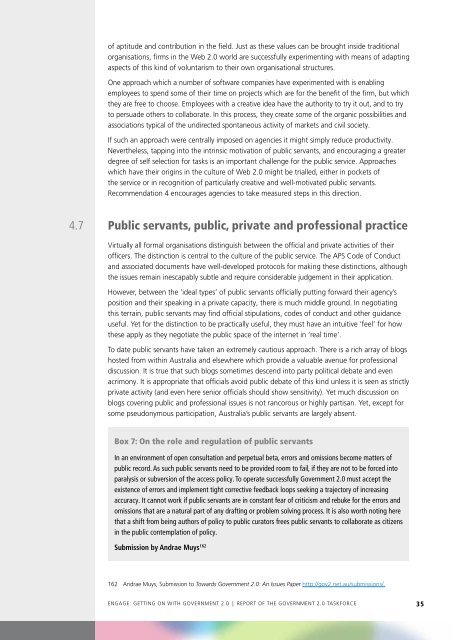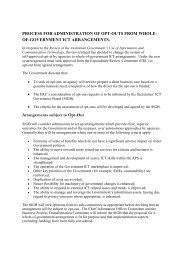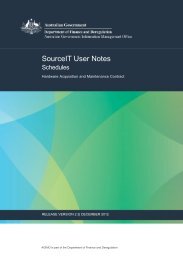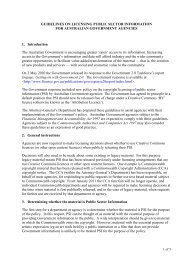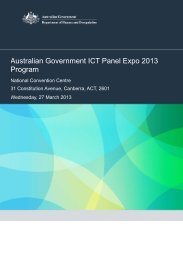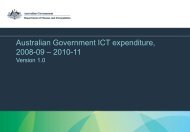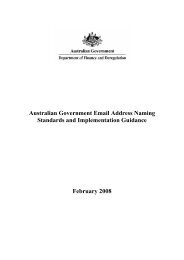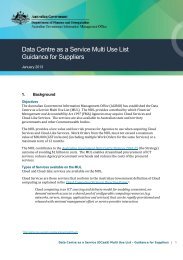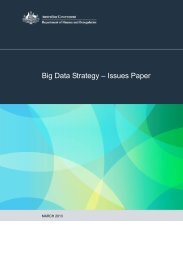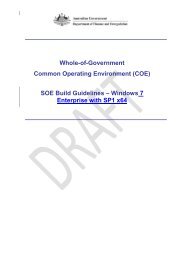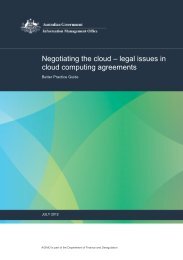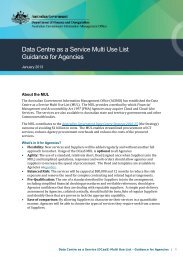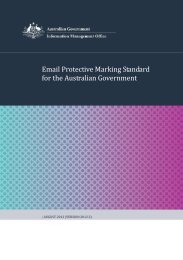Getting on with Government 2.0 - Department of Finance and ...
Getting on with Government 2.0 - Department of Finance and ...
Getting on with Government 2.0 - Department of Finance and ...
You also want an ePaper? Increase the reach of your titles
YUMPU automatically turns print PDFs into web optimized ePapers that Google loves.
<strong>of</strong> aptitude <strong>and</strong> c<strong>on</strong>tributi<strong>on</strong> in the field. Just as these values can be brought inside traditi<strong>on</strong>al<br />
organisati<strong>on</strong>s, firms in the Web <strong>2.0</strong> world are successfully experimenting <strong>with</strong> means <strong>of</strong> adapting<br />
aspects <strong>of</strong> this kind <strong>of</strong> voluntarism to their own organisati<strong>on</strong>al structures.<br />
One approach which a number <strong>of</strong> s<strong>of</strong>tware companies have experimented <strong>with</strong> is enabling<br />
employees to spend some <strong>of</strong> their time <strong>on</strong> projects which are for the benefit <strong>of</strong> the firm, but which<br />
they are free to choose. Employees <strong>with</strong> a creative idea have the authority to try it out, <strong>and</strong> to try<br />
to persuade others to collaborate. In this process, they create some <strong>of</strong> the organic possibilities <strong>and</strong><br />
associati<strong>on</strong>s typical <strong>of</strong> the undirected sp<strong>on</strong>taneous activity <strong>of</strong> markets <strong>and</strong> civil society.<br />
If such an approach were centrally imposed <strong>on</strong> agencies it might simply reduce productivity.<br />
Nevertheless, tapping into the intrinsic motivati<strong>on</strong> <strong>of</strong> public servants, <strong>and</strong> encouraging a greater<br />
degree <strong>of</strong> self selecti<strong>on</strong> for tasks is an important challenge for the public service. Approaches<br />
which have their origins in the culture <strong>of</strong> Web <strong>2.0</strong> might be trialled, either in pockets <strong>of</strong><br />
the service or in recogniti<strong>on</strong> <strong>of</strong> particularly creative <strong>and</strong> well-motivated public servants.<br />
Recommendati<strong>on</strong> 4 encourages agencies to take measured steps in this directi<strong>on</strong>.<br />
4.7 Public servants, public, private <strong>and</strong> pr<strong>of</strong>essi<strong>on</strong>al practice<br />
<br />
Virtually all formal organisati<strong>on</strong>s distinguish between the <strong>of</strong>ficial <strong>and</strong> private activities <strong>of</strong> their<br />
<strong>of</strong>ficers. The distincti<strong>on</strong> is central to the culture <strong>of</strong> the public service. The APS Code <strong>of</strong> C<strong>on</strong>duct<br />
<strong>and</strong> associated documents have well-developed protocols for making these distincti<strong>on</strong>s, although<br />
the issues remain inescapably subtle <strong>and</strong> require c<strong>on</strong>siderable judgement in their applicati<strong>on</strong>.<br />
However, between the ‘ideal types’ <strong>of</strong> public servants <strong>of</strong>ficially putting forward their agency’s<br />
positi<strong>on</strong> <strong>and</strong> their speaking in a private capacity, there is much middle ground. In negotiating<br />
this terrain, public servants may find <strong>of</strong>ficial stipulati<strong>on</strong>s, codes <strong>of</strong> c<strong>on</strong>duct <strong>and</strong> other guidance<br />
useful. Yet for the distincti<strong>on</strong> to be practically useful, they must have an intuitive ‘feel’ for how<br />
these apply as they negotiate the public space <strong>of</strong> the internet in ‘real time’.<br />
To date public servants have taken an extremely cautious approach. There is a rich array <strong>of</strong> blogs<br />
hosted from <strong>with</strong>in Australia <strong>and</strong> elsewhere which provide a valuable avenue for pr<strong>of</strong>essi<strong>on</strong>al<br />
discussi<strong>on</strong>. It is true that such blogs sometimes descend into party political debate <strong>and</strong> even<br />
acrim<strong>on</strong>y. It is appropriate that <strong>of</strong>ficials avoid public debate <strong>of</strong> this kind unless it is seen as strictly<br />
private activity (<strong>and</strong> even here senior <strong>of</strong>ficials should show sensitivity). Yet much discussi<strong>on</strong> <strong>on</strong><br />
blogs covering public <strong>and</strong> pr<strong>of</strong>essi<strong>on</strong>al issues is not rancorous or highly partisan. Yet, except for<br />
some pseud<strong>on</strong>ymous participati<strong>on</strong>, Australia’s public servants are largely absent.<br />
Box 7: On the role <strong>and</strong> regulati<strong>on</strong> <strong>of</strong> public servants<br />
In an envir<strong>on</strong>ment <strong>of</strong> open c<strong>on</strong>sultati<strong>on</strong> <strong>and</strong> perpetual beta, errors <strong>and</strong> omissi<strong>on</strong>s become matters <strong>of</strong><br />
public record. As such public servants need to be provided room to fail, if they are not to be forced into<br />
paralysis or subversi<strong>on</strong> <strong>of</strong> the access policy. To operate successfully <strong>Government</strong> <strong>2.0</strong> must accept the<br />
existence <strong>of</strong> errors <strong>and</strong> implement tight corrective feedback loops seeking a trajectory <strong>of</strong> increasing<br />
accuracy. It cannot work if public servants are in c<strong>on</strong>stant fear <strong>of</strong> criticism <strong>and</strong> rebuke for the errors <strong>and</strong><br />
omissi<strong>on</strong>s that are a natural part <strong>of</strong> any drafting or problem solving process. It is also worth noting here<br />
that a shift from being authors <strong>of</strong> policy to public curators frees public servants to collaborate as citizens<br />
in the public c<strong>on</strong>templati<strong>on</strong> <strong>of</strong> policy.<br />
Submissi<strong>on</strong> by Andrae Muys 162<br />
162 Andrae Muys, Submissi<strong>on</strong> to Towards <strong>Government</strong> <strong>2.0</strong>: An Issues Paper http://gov2.net.au/submissi<strong>on</strong>s/.<br />
Engage: <str<strong>on</strong>g>Getting</str<strong>on</strong>g> <strong>on</strong> <strong>with</strong> <strong>Government</strong> <strong>2.0</strong> | report <strong>of</strong> the government <strong>2.0</strong> taskforce<br />
35


